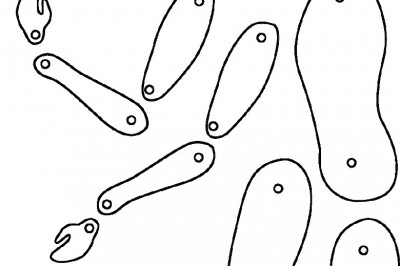
Cumulative Trauma Disorders (CTDs) are injuries that are related to, or are a direct result of work characteristics and performance. CTDs are related to the exposure of an individual to specific ergonomic or work-related risk factors. A risk factor is any attribute, experience or exposure that increases the probability of the occurrence of a disease or disorder, although it is not necessarily a causal factor. Workplace risk factors that are thought to increase the likelihood of CTDs include; forceful exertion, repetition, static and dynamic work, awkward postures, environmental factors and confounding factors.
Jobs that have multiple risk factors present are thought to be at an increased risk for the development of CTDs in the workplace. The level of risk for developing CTDs is dependent on the exposure to the ergonomic risk factor. Factors of exposure include: intensity of risk factor, duration of exposure and frequency of exposure. The level of risk is also dependent upon individual characteristics, including the capacity to meet job demands.
Since CTDs are injuries that result from exposure to workplace risk factors, it is logical that by identifying workplace risk factors and reducing or eliminating them that we can reduce the incidence of CTDs in the workplace. This is the goal of the Health Ergonomics approach to injury reduction. Reducing work-related injuries can be accomplished effectively by correctly identifying the ergonomic risk factors that are present and by providing a method for reducing the ergonomic risk or the exposure of the worker to the ergonomic risk factor. Both methods ultimately reduce the likelihood of the work-related injury and CTDs from developing by reducing the tissue fatigue and micro trauma thus facilitating optimal worker performance and minimizing worker fatigue.
Principles of Workplace Injury Prevention
The principles of workplace injury prevention are based on the foundation that if we reduce the ergonomic risk factors at the workplace, we can effectively reduce worker fatigue and the tissue microtrauma that occurs when the tissues are overloaded and insufficient recovery times. Reducing work-related injuries can be accomplished by correctly identifying the ergonomic risk factors and providing a method for reducing the ergonomic risk or the exposure of the worker to the ergonomic risk factor. The methods for reducing the risk factor or the exposure to the ergonomic risk factor are called control measures. Control measures use the principles of workplace injury prevention to provide suggestions for reducing the ergonomic risk.
The principles of workplace injury prevention include any work modification that will reduce the degree and severity of the ergonomic risk factor or will reduce the worker's exposure to the risk factor. Principles of injury prevention are based on the two health ergonomic objectives of reducing worker fatigue and improving worker performance. By reducing the amount and degree of tissue fatigue and introducing additional recovery times, the working tissues will recovery at a higher rate thus minimizing and preventing the onset of tissue micro trauma and CTDs. Injury prevention principles for the shoulder focus on improving blood flow to the local working tissues and reducing the degree of stress on to the working joints and muscles of the shoulder region.
Injury Prevention Principles for the Shoulder Joint:
1. Reduce High Repetition. Reducing high repetition will both reduce tissue stress and allow increased blood flow to the working muscle tissues, thus preventing tissue overload and microtrauma. This is especially critical in high stress activities such as; overhead lifting and reaching; forward lifting; forward reaching; and activities that require shoulder abduction and horizontal abduction positions.
2. Reduce Forceful exertions. Reducing forceful exertions will both reduce tissue stress and allow increased blood flow to the working muscle tissues, thus preventing tissue overload and microtrauma. The proper use of body mechanics is important to reduce the strain on the shoulder structures. Use the whole body and larger shoulder muscle groups to exert force and accomplish work tasks as opposed to using the smaller shoulder muscle groups or the shoulder joint only, when generating a force.
3. Reduce Static Work and Static Muscle Contractions. Reduce static work and static muscle contractions to allow increase blood flow to the working muscle tissues, thus preventing tissue overload and microtrauma. If static work is required, emphasize good posture and the use of the stronger, larger shoulder muscles. Rehabilitation should focus on the strength and endurance of the stabilizing muscles including the scapular stabilizers and the rotator cuff. If dynamic work is required, emphasize good posture and the use of the stronger, larger shoulder muscles. Rehabilitation should focus on the strength and endurance of the stabilizing muscles including the scapular stabilizers and the rotator cuff.
4. Dynamic Work-rest Cycles. Ensure dynamic work cycles are adequate to allow sufficient blood flow to working tissues to prevent tissue overload and microtrauma.
5. Reduce Postural Joint Forces and Awkward Positions. Reducing postural joint forces and awkward positions this will both reduce tissue and joint stress while allowing increased blood flow to the working muscle tissues, thus preventing tissue overload and microtrauma. For the shoulder joint, promote and maintain, as much as possible, the ideal positions of the shoulder joint that produce the least amount of exertion and compressive stresses to the joint and shoulder structures. Minimize lifting and reaching over 90 degrees of shoulder abduction, flexion and horizontal abduction. In addition, minimize shoulder extension activities beyond the midline. It is important to promote good postures of the neck, elbow and wrist joints, as awkward positions at adjoining joints may result in awkward positions and excessive tissue strain in the shoulder region. By minimizing the awkward postures at the joints above and below the shoulder joint, proper postures of the shoulder joint will be encouraged and therefore the risk for CTDs will be reduced.
6. Reduce Environmental Risk Factors. Reducing environmental risk factors to acceptable exposure limits will reduce tissue stress, enhanced worker performance and allow increased blood flow to working tissues, thus preventing tissue overload and microtrauma.
7. Reduce Confounding Risk Factors. Reducing confounding risk factors will enhance worker performance and reduce local tissue fatigue, thus preventing workplace injuries.
If a job task involves high repetition; the risk factor is high repetition, the injury prevention principle is to reduce the tissue stress and allow increased blood flow to the working tissues, the control measure will be to reduce the repetition rate or work rate and/or implement more frequent rest breaks. In effect, reducing the tissue stress and allowing a better recovery phase for the working tissues, thus preventing the CTDs from developing.
If the job task involves static postures; the risk factor is static work or static postures, the injury prevention principle is to reduce the tissue stress and allow increased blood flow to the working tissues, the control measure is to reduce the amount of static work by implementing dynamic work or by changing the work-rest cycles and allowing a longer tissue recovery time.
If the job task involves awkward postures; the risk factor is awkward postures, the injury prevention principles are to reduce the joint strain and promote a more neutral joint position, the control measure may be to implement ergonomic tools to improve the position of the joint to a more neutral position. This will reduce the joint stress and reduce the likelihood of tissue microtrauma from occurring, thus preventing the CTD.





























